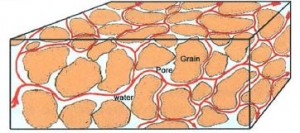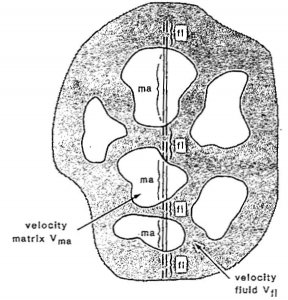A simple definition of porosity or the amount of pore space is the volume of space within a rock which can be occupied by gas (air) or a fluid (water, oil).
Measuring the porosity of a rock will give an indication of its storage potential for groundwater, oil or gas. An important quantity for investment purposes.
There are many types of porosity:
- Intergranular porosity, fracture porosity, secondary porosity.
- Total porosity, effective porosity, interconnected porosity.
Core samples from a borehole can be sent to a laboratory to measure porosity. This is commonly a slow and expensive process.
A number of wireline logging methods are able to measure porosity as the measurement technique is influenced by the porosity of a rock. The three most common are density, sonic and neutron porosity.
Density Porosity
The formation density measurement is a function of the density of the rock grain (matrix), the amount of pore space (porosity) and the fluid/gas filling the pore spaces. Using a fractional equation and assumptions for the density of the matrix and fluid, porosity values can be calculated.
Sonic Porosity
The velocity of an acoustic or sonic signal travelling through the rock is a function of its time spent in the rock grains (matrix) and time spent in the fluid within the pores. This relationship is expressed by a mathematical expression known as the “Time Average Equation”. In much the same way as the density porosity, by assuming a velocity (or transit time) for the matrix and the fluid, porosity values can be calculated.
Neutron Porosity
Neutron porosity is a more direct porosity measurement in that neutrons generated from the source at the bottom of the probe lose most of their energy when colliding with atoms of a similar size – this means hydrogen. In the rock, most hydrogen is present in water – within the pore space of a sandstone or limestone. Commonly known as the Hydrogen Index, the ratio of the long and short spaced neutron detectors provide a good measurement of the formation porosity.
Resistivity
The resistivity measurements are used in conjunction with porosity to calculate the presence and amount of hydrocarbons in a pore space through a mathematical expression known as Archie’s Equation.
Rocks with matrix grains only and no pore space are typically highly resistive (shales/clays and their associates are exceptions). Introducing pore space filled with fluid will result in a significant decrease in the measured resistivity which can be related to porosity. However, there are a number of other influencing factors which can affect the measurement, namely, the conductivity of the fluid in the pore space (fresh – saline water), the rock texture which can affect the resistivity measurements, clay minerals which can have a significant effect on the resistivity measurement and the formation temperature.



